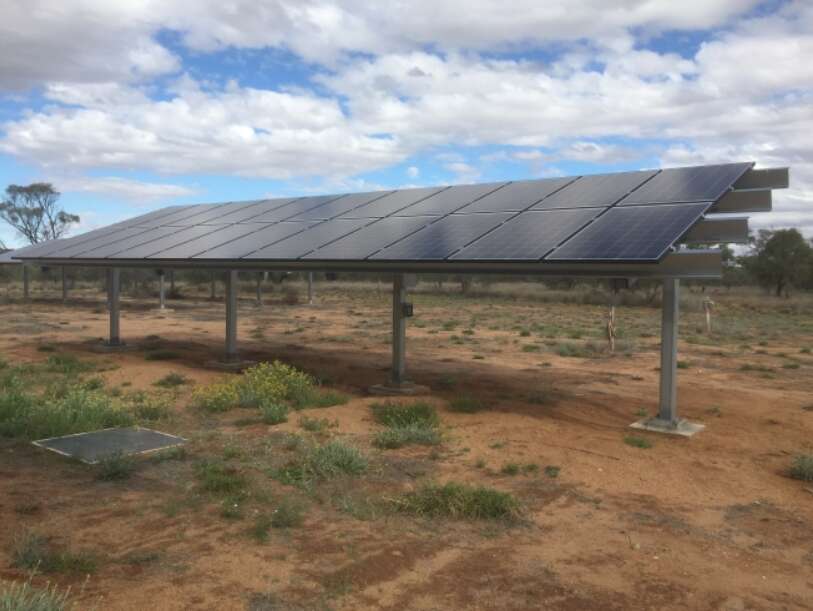| Manufacturer | Tindo |
|---|---|
| Array Rating | 5.5kW |
| PV Technology | poly-Si |
| Array Structure | Fixed: Ground Mount |
| Installed | 2016 |
View on Map Graphs Download Data
Current Output

Polycrystalline silicon array, fixed ground-mount
At the heart of the Karra-250 photovoltaic module is brilliant technical and intelligent design fused with a range of innovative materials that make it the ultimate solar panel.
Everybody should have a panel this advanced.
The Tindo
Karra-250 solar panel is manufactured in Australia and we invite you to visit
our factory to watch panels being created.
You will love the Karra-250, the most beautiful solar panel … in the world.
At Tindo, we want a 25 year warranty to actually mean something. So we have designed and are manufacturing a module without compromise. Our partners are global solar industry leaders who zealously value their fine reputations. Tindo Solar is proud to be associated with them. In addition to the 250W panels installed at Desert Knowledge, Tindo also manufacture a range of other modules in its Mawson Lakes factory.
Our Production Line
Tindo
operates a state of the art 60MW capacity production line in Adelaide South
Australia.
Our line is fully automated with a focus on quality control and sophisticated
engineering.
Bridgestone EVA
EVA from Bridgestone has a long history in the solar panel industry providing encapsulation material of the highest quality. Bridgestone’s EVA is optically clear, impervious to water and can be relied on for decades.
Dow Corning Silicone
Silicone edge seal from Dow Corning has been a performer of the highest calibre, proven since panels were first commercialised. Tests show the seal outperforms all competition in cohesiveness and lap shear strength.
DuPont Back Sheet
Tindo uses DuPont Tedlar film-based backsheets in the manufacture of the Karra-250. Back sheets are used as a vapour barrier and to protect sensitive components of the panels. Tedlar is the only film based back sheet that has successfully protected solar panels for more than 25 years.
Commitment to Quality
At Tindo we are committed to providing an Australian product that can be benchmarked against any panel in the world. We have taken extensive steps to ensure the quality and reliability of our panels. Tindo is Made for Life.
Electroluminescence Testing
Visual testing of the surface of solar panels does not provide adequate assurance of the quality of a module.
There are numerous defects in a solar
cell for example:
• cracks caused during production or transportation of solar cells,
• fingerprints that were left behind on cells while printing the cell grid,
• micro cracks caused by heat stress while stringing,
• cracks caused by faulty handling in the module production line,
• defect contact point between ribbons and cells
All of these defects can cause substantial reduction of the quality of modules. Though modules may generate adequate output immediately after they have been produced, cracks can at a later point in time (even years later) be the reason for substantial output reductions or loss of production.
Tindo uses an Electroluminescence (EL) Tester on each panel that we produce. This provides a reliable quality control system for solar panels in which all defects are detected so you as the end consumer can be assured of output from your panels well into the future.
Flash Testing
As part of the final step of the production process, each Tindo panel is Flash tested.
During a flash test the panel is exposed to a flash of light from a xenon filled arc lamp. The output spectrum of this lamp is as close to the spectrum of the sun as possible. The output from this flash test is validated to ensure that the solar panel is performing as rated to its specifications.
We will only send the panel out to the consumer if we are satisfied that the panel produces as its nameplate suggest.
Visual Inspection
We have numerous visual inspection points to ensure that the Tindo panels are Made for Life.
These include:
Inspection to ensure the there are no air bubbles or blisters in the lamination process
Junction box has been sealed correctly to the back of the module.
Framing has formed a water tight seal to protect the cells
The above technology description has been supplied by the manufacturer. The Desert Knowledge Australia Solar Centre is pleased to provide a platform for information sharing while not endorsing specific claims made about technologies installed at the site.
| Array Rating | 5.5kW |
|---|---|
| Panel Rating | 250W |
| Number Of Panels | 22 |
| Panel Type | Karra 250 |
| Array Area | 36.67 m2 |
| Type Of Tracker | N/A |
| Inverter Size / Type | 270W - Enphase S270 (22 of) |
| Installation Completed | Tue, 28 Jun 2016 |
| Array Tilt/Azimuth | Tilt = 20, Azi = 0 (Solar North) |

Notes on the Data
-
Site #37 - Fault
Due to a tripping MCB Site #37 has been operating on 50% capacity since 25-04-2022. The MCB has now been reset and the system returned to 100% capacity.
-
Metering failure
Circuit breaker supplying the metering equipment for sites 23-38 tripped off on Aug 19th and was discovered and turned back on on Aug 23rd. This resulted in a lack of generation data for these sites during this time but did not stop the sites from physically generating.
-
System Disconnection for Cabling Works
All arrays at the Solar Centre were disconnected from approximately 2.00pm to 3.00pm on Monday, 9 July 2018 in preparation for the cable between the main switchboard and distribution board being upgraded. Array sites #23-38 remained disconnected while the main feeder cable to these sites was replaced in subsequent days, but all systems were re-connected by early afternoon on Thursday, 12 July 2018.
-
System Outage at Australia Day Long Weekend
A breaker tripped at around 12.30pm on Friday, 26 January, likely due to high generation levels reached at this peak time on this high irradiance day. Connection was restored after the Australia Day long weekend at around 11.30am on Monday, 29 January but shortly tripped again.
UPDATE 26-02-2018. The cause of this reoccurring issue has been identified and will be rectified. The solution requires the upgrading of a key distribution cable. This should be completed in the coming months.
-
Connection Restored After Christmas/NY Period
Arrays have been re-connected following the outage that disconnected multiple sites from Christmas day 2017. The outage is believed to have been triggered by the tripping of two circuit breakers in separate distribution boards, making the diagnosis initially elusive. The ability of the common circuit shared by these arrays to keep abreast with increasingly high current demands as new arrays are installed and generation conditions are high is presently being addressed. For the same reason, intermittent outages persisted in the summer of early 2018.
-
System Outage at Christmas/NY Period
A system outage was caused by a circuit breaker trip at approximately 2pm on a high generation day shortly after installation of a new array at the DKA Solar Centre. The outage commenced on 25 December continuing into the new year and is being addressed.
-
System Outage for New Array Connection
Sites 23 through to 37 experienced an outage today from 11:10 to 11:50. The outage was due to the local distribution board being temporarily being taken offline to allow for the connection of a new PV system.
-
Monitoring Interruption for UPS Battery Replacement
The disconnection and re-connection of the solar arrays and weather station equipment while a new site connection was being established prompted the already flattening UPS batteries which power the site’s energy meters to fail and require immediate replacement. Data recording was affected from approximately 2.30pm ACST, Monday 10 July to 4.00pm, Wednesday 12 July.
Affects weather data for DKASC, Alice Springs
-
Partial System Outage
One of the major switchboards at the DKASC lost power yesterday 01/12/2016 at ~11:00 am. This isolated and shutdown array sites 23 through to 37 inclusive. The switchboard was re-energised at ~16:30 today (02/12/2016) and is again operating normally. Data for this period for these sites is lost.
> Answer to Spotlight Question
Onsite at the DKA Solar Centre in Alice Springs are a series of quiz-like Spotlight Questions at each array. Visit the centre and scan the QR code at each sign to test your knowledge – and check your answer here!
Q: Can you guess what the following solar mounting components do? End clamps, Mid clamps, base rail, feet… See if you can point to them on the array!
A: End clamps and mid clamps are typically used to fix solar modules onto their underlying metal frame: mid clamps are installed between two adjacent modules, while end clamps are used at the end of a row, gripping onto only one module. Base rail is a kind of long, slender metal beam onto which modules may be fixed. Feet, which come in many configurations, are the small connecting parts that allow the base rail (on which the modules are mounted) to be fixed upon the underlying infrastructure such as the purlins of a roof (tucking into the roof tiles or clipping/bolting onto the corrugations of a metal roof profile, for example). These mounting ancillaries are fairly standard parts but can vary for ground-mounted, tracking or bespoke applications, adapting to the mounting requirements at hand. This particular array uses end clamps and mid clamps bolted to metal purlins.

